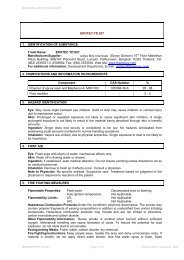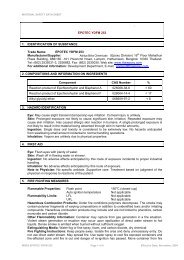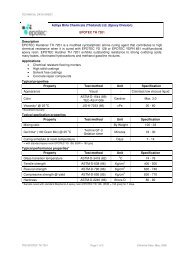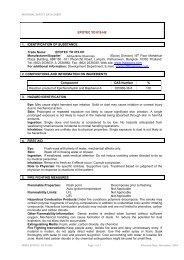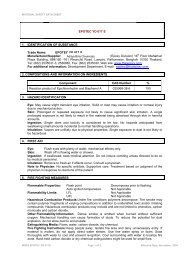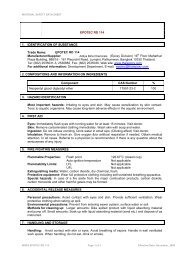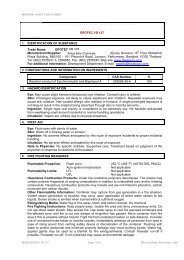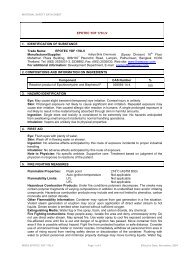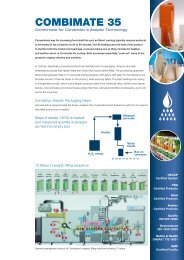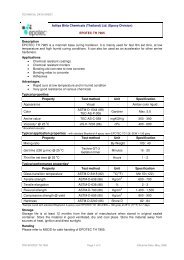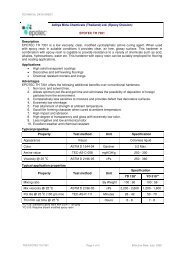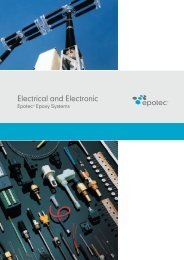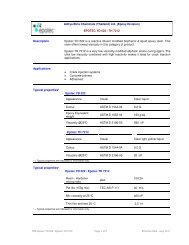Chlorinated trisodium phosphate - Aditya Birla Chemicals
Chlorinated trisodium phosphate - Aditya Birla Chemicals
Chlorinated trisodium phosphate - Aditya Birla Chemicals
Create successful ePaper yourself
Turn your PDF publications into a flip-book with our unique Google optimized e-Paper software.
Thai Poly<strong>phosphate</strong> and <strong>Chemicals</strong> Co., Ltd.<br />
Bangkok, Thailand<br />
MATERIAL SAFETY DATA SHEET<br />
CHLORINATED TRISODIUM PHOSPHATE (TSP-Cl)<br />
SECTION 1: CHEMICAL PRODUCT & COMPANY IDENTIFICATION<br />
Date of Issue: 27/09/03<br />
Rev-02<br />
1.1 Product Details<br />
1.1.1 Product name CHLORINATED TRISODIUM PHOSPHATE<br />
1.1.2 Chemical name <strong>Chlorinated</strong> Trisodium Phosphate<br />
1.1.3 Chemical formula [Na 3 PO 4 .11H 2 O] 4. NaOCI<br />
1.2 Company Thai Poly<strong>phosphate</strong> & <strong>Chemicals</strong> Co.,Ltd.<br />
77 Moo 6 Soi Sukhaphiban 1,<br />
Poochao Saming Prai Road,<br />
Samrong, Phrapradaeng,<br />
Samutprakarn 10130<br />
Telephone: +66 (0) 2396 1715-6, 2748 5173 – 4<br />
Fax: +66 (0) 2398 0774<br />
E-mail: mktg@thaipoly.co.th<br />
Website: www.thaipoly.com<br />
1.3 Emergency Telephone: +66 (0) 2396 1715 - 6, 2748 5173 – 4<br />
SECTION 2: COMPOSITION<br />
2.1 Ingredients Trisodium Phosphate <strong>Chlorinated</strong><br />
Formula: [Na 3 PO 4 .11H 2 O] 4 . NaOCI<br />
2.2 CAS Number 11084-85-8<br />
R36/38 - Irritating to eyes and skin.<br />
R31 - Contact with acids liberates toxic gas.<br />
SECTION 3: HAZARDS<br />
3.1 Moderate eye and skin irritant particularly under wet conditions.<br />
3.2 Liberates chlorine when in contact with acids.<br />
3.3 Will decompose above 60 o C to liberate water, oxygen and chlorine.<br />
SECTION 4: FIRST AID MEASURES<br />
4.1 Eye Contact Wash with plenty of water for at least 15 minutes<br />
and seek medical advice<br />
4.2 Skin contact Wash with plenty of water and seek medical<br />
advice if irritation persists.<br />
4.3 Inhalation Remove to a well-ventilated area and seek<br />
medical attention if required.<br />
4.4 Ingestion If significant quantities are ingested, drink plenty<br />
of water and obtain medical advice.<br />
Page 1 of 4<br />
MSDS/PHOS/08
Thai Poly<strong>phosphate</strong> and <strong>Chemicals</strong> Co., Ltd.<br />
Bangkok, Thailand<br />
MATERIAL SAFETY DATA SHEET<br />
SECTION 5: FIRE-FIGHTING MEASURES<br />
5.1 Governed by other materials present. In the event of a fire, self-contained breathing<br />
apparatus is advised.<br />
SECTION 6: ACCIDENTAL RELEASE MEASURES<br />
6.1 Goggles or face shield, dust, mark (3M H8500 or equivalent) and PVC gloves should be<br />
used.<br />
6.2 Spillages should be swept up and placed in polylined fiberboard kegs or plastic drums.<br />
Avoid contact with acids (see 3.0 above)<br />
6.3 Recover/recycle if possible, otherwise retain on site for temporary storage and consult your<br />
local Waste<br />
6.4 Authority for disposal instructions. (See also 13.0 below)<br />
SECTION 7: HANDLING & STORAGE<br />
7.1 Handling Wear gloves, dust mark (3M H8500 or<br />
equivalent) and goggles when handling this<br />
powder. Attempt to avoid wet conditions where<br />
prolonged contact can cause eye and skin<br />
inflammation.<br />
7.2 Storage Store containers in a cool dry area to avoid loss<br />
of available chlorine.<br />
SECTION 8: EXPOSURE CONTROLS AND PERSONAL PROTECTION<br />
8.1 There is no published air contamination limit but due to the irritant effect on mucous<br />
membranes the EH40 general dust requirement should be enforced.<br />
Total inhalable dust: 10 mg/m 3 8 hr TWA<br />
Total inhalable dust: 10 mg/m 3 8 hr TWA<br />
8.2 When working with this chemical personal protection equipment is specified as follows<br />
8.2.1 Respiratory protection Dust mark when handling powders<br />
8.2.2 Hand protection PVC or leather gloves.<br />
8.2.3 Eye protection Safety goggles or face shield<br />
8.2.4 Skin (body) protection Industrial coverall<br />
8.2.5 Foot protection Safety boots<br />
8.2.6 Head protection Safety helmet<br />
Page 2 of 4<br />
MSDS/PHOS/08
Thai Poly<strong>phosphate</strong> and <strong>Chemicals</strong> Co., Ltd.<br />
Bangkok, Thailand<br />
MATERIAL SAFETY DATA SHEET<br />
SECTION 9: PHYSICAL AND CHEMICAL PROPERTIES<br />
9.1 Appearance Normally white powder (may be dyed pink) with<br />
faint chlorine odour.<br />
9.2 Bulk Density 0.84 g/ml.<br />
9.3 Vapour pressure Not applicable<br />
9.4 Viscosity Not applicable<br />
9.5 Solubility 20g per 100g water at 20 o C<br />
9.6 pH Value 11.7 at 20 o C (1% Soln)<br />
9.7 Flash point Not applicable<br />
9.8 Ignition temperature Does not burn or help other materials to burn<br />
9.9 Explosion limits Not relevant<br />
SECTION 10: STABILITY AND REACTIVITY<br />
10.1 Thermal decomposition Decomposes above 60 o C first losing water then<br />
chlorine to yield a sodium <strong>phosphate</strong> residue<br />
which melts at temperature greater than 1000 o C<br />
10.2 Hazardous reactions May react with acids to liberate a toxic gas<br />
(chlorine). Avoid contact also with caustic<br />
alkalis, peroxy – salts (perborate and<br />
percarbonate), reducing agents, cationic<br />
surfactants and many readily chlorinated nonionic<br />
surfactants.<br />
SECTION 11: TOXICOLOGICAL INFORMATION<br />
11.1 LD50 oral rats = 5000 - 10,000 mg/kg. Due to its hypo chlorite content and high pH value<br />
this material can irritate skin, eyes and mucous membranes particularly under wet or damp<br />
conditions when inflammation may result.<br />
SECTION 12: ECOLOGICAL INFORMATION<br />
12.1 Ecological effects High concentrations in receiving waters will<br />
injure aquatic life by raising pH and by<br />
chlorination effect. The ortho<strong>phosphate</strong> can act<br />
as a plant nutrient and precipitate heavy metals.<br />
SECTION 13: DISPOSAL CONSIDERATIONS<br />
Page 3 of 4<br />
MSDS/PHOS/08
Thai Poly<strong>phosphate</strong> and <strong>Chemicals</strong> Co., Ltd.<br />
Bangkok, Thailand<br />
MATERIAL SAFETY DATA SHEET<br />
13.1 Spillages should be swept up and placed in polylined fiberboard kegs or plastic drums.<br />
Avoid contact with acids (see 3.0 above)<br />
13.2 Recover/recycle if possible otherwise retain on site for temporary storage and consult your<br />
local Waste Authority for disposal instructions.<br />
13.3 Treat empty packages as contaminated waste.<br />
SECTION 14: TRANSPORT INFORMATION<br />
14.1 Not classified as a substance hazardous for transport.<br />
SECTION 15: REGULATORY INFORMATION<br />
15.1 Label according to Directives 67/548/EEC and 88/379/EEC, 91/325/EEC* and 1993 CHIP<br />
Regulations.<br />
[*12th Adaptation to technical progress (including classification 'Dangerous for the<br />
Environment') to take effect July 1, 1992) R&S phrases shown in bold print.]<br />
15.2 R36/38 - Irritating to eyes and skin.<br />
15.3 R31 - Contact with acids liberates toxic gas.<br />
15.4 S26 - In case of contact with eyes, rinse immediately with plenty of water and seek<br />
medical advice.<br />
SECTION 16: OTHER INFORMATION<br />
16.1 TPC supplies chlorinated Trisodium <strong>phosphate</strong> for these applications: Cleaning and<br />
Sterilizing, Stain removal, and Detergent formulations.<br />
16.2 Technical Note - Carbon monoxide can be formed by the atmospheric oxidation of some<br />
organic compounds under warm, alkaline conditions. The compounds include certain reducing<br />
sugars, sugar alcohols and complex phenols - common constituents of foods and other natural<br />
products. Where a closed vessel may have contained any of the above compounds and a person<br />
needs to enter during, or after, alkaline cleaning, test the atmosphere for carbon monoxide and<br />
oxygen as part of the procedure for vessel - entry. This advice applies whether or not a<br />
<strong>phosphate</strong> has been used and is given here only because of a report that <strong>phosphate</strong>s can increase<br />
the evolution of carbon monoxide.<br />
DISCLAIMER: Every endeavor has been made to ensure that the information contained in this leaflet reliable<br />
but we cannot accept liability for any loss, injury or damage which may result from it use. Data given in this<br />
Material Safety Data Sheet are solely for guidance in safe handling and use of the product (s) by customers.<br />
They do not form part of any specification. Any liability is not acceptable since application of this product is<br />
not in our control.<br />
Page 4 of 4<br />
MSDS/PHOS/08



